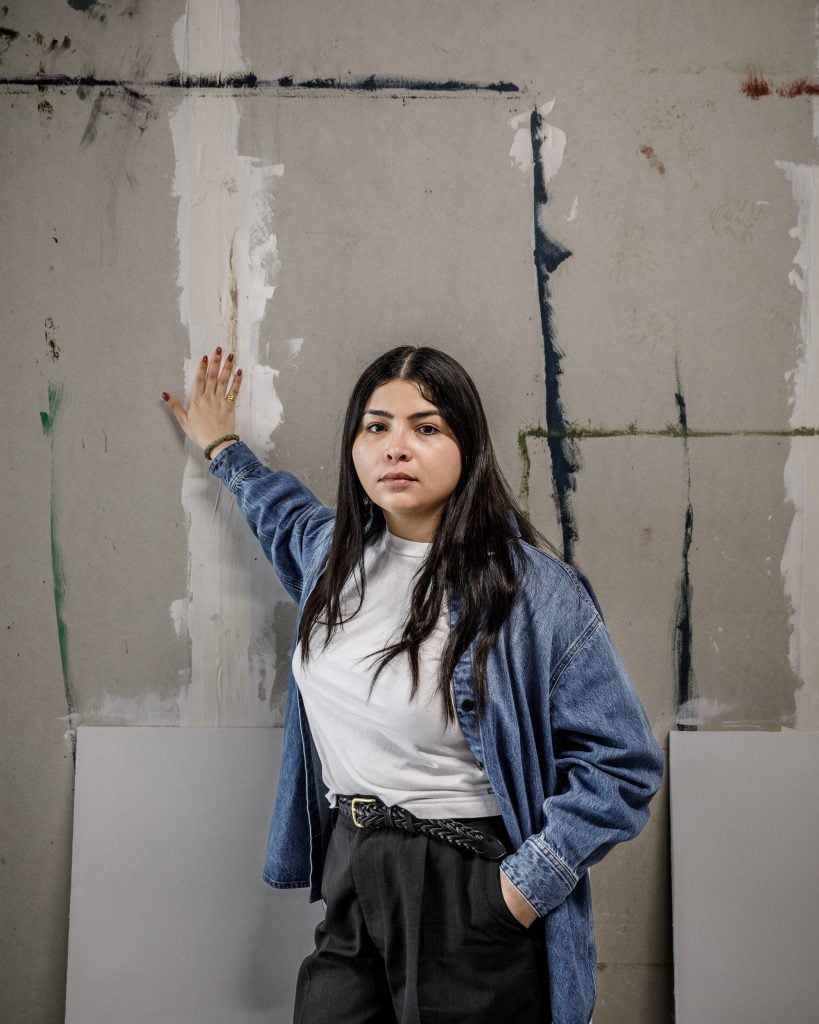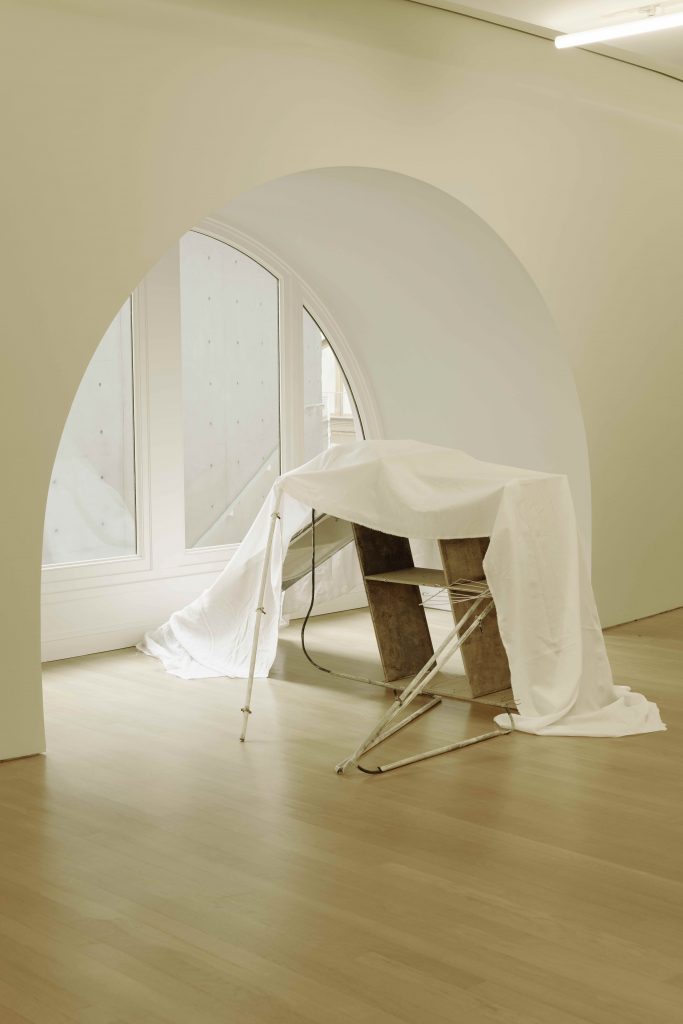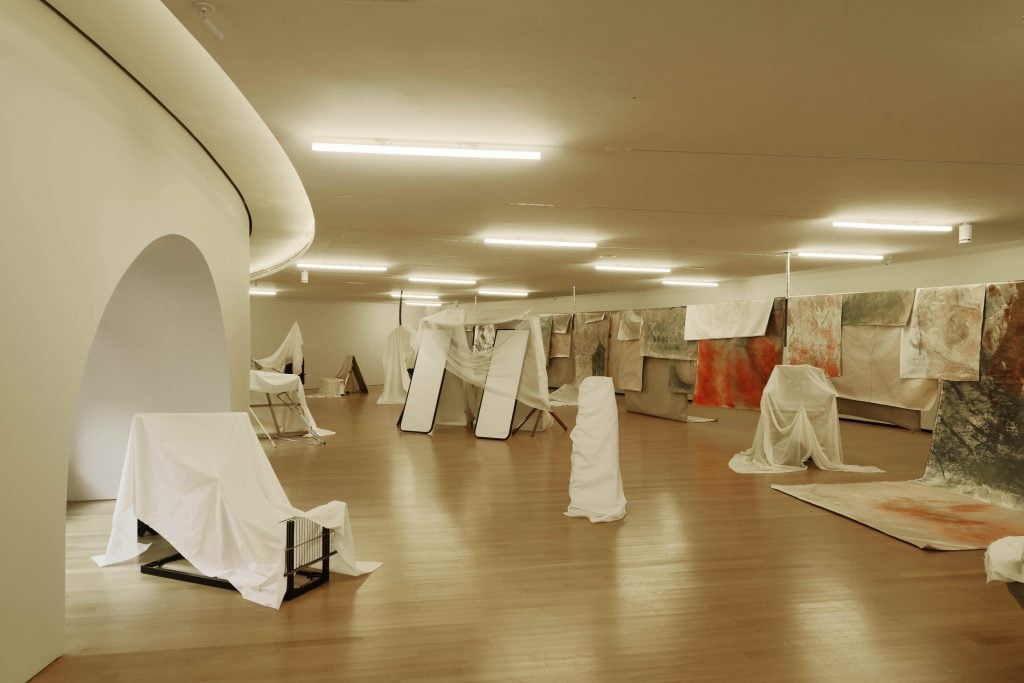Artists
Ser Serpas Creates Uncanny Sculptural Landscapes. No Small Wonder That Her Next Dream Project Is a Horror Movie
The emerging star discusses the indie film that finding beauty in the most unlikely places.

The emerging star discusses the indie film that finding beauty in the most unlikely places.

Devorah Lauter

On a recent weekend, at the entrance to Ser Serpas’s current exhibition at the Bourse de Commerce in Paris, a tour guide explained the meaning of the word “hybrid” to a group of grade school children, standing before the artist’s sculptures, contorted combinations of found objects draped with white cloth, like ghostly furniture in an abandoned attic. These are hybrid forms, she told the kids; a centaur was another example of a hybrid. “She made these sculptures,” said the guide. “The centaur made them?” asked one boy.
Serpas would have likely appreciated the comparison. Her work, shown in institutions and galleries including the LUMA Westbau, Zurich, the Swiss Institute, New York, and, until December 9, at Maxwell Graham, New York, suggests we are all infinitely varied hybrids. The artist also examines themes of bodily transformation, both in others, and her own (she is trans), though she has never explicitly identified herself in her paintings, which can reference photos of her body, or those of friends, as well as anonymous images of before and after plastic surgery.

Ser Serpas, “I fear (j’ai peur)” installation view at La Bourse de Commerce, Paris
For her exhibition at Bourse de Commerce, called “I fear (j’ai peur)” (On view until January 22, 2024), Serpas’s sculptures were constructed with a group of artists from an array of gaping bed frames, as well as a sink, bent metal, plywood, storage devices, and a worn, faux leather office chair. In a September performance at the Bourse titled Basement Scene, five individuals collaborated with Serpas to create the works in an event accompanied by her D.J. set, in a burst of “fluid action.” She compared the experience to a “weird Judson Church” improvisation, but also, a key turning point in her practice.
“It was a total shock how it came together in the end,” she said in an interview over Zoom. “[In the performance] I gave up so much agency, but also created something that kind of transcended me out of that.” Rather than working according to a mapped plan, the process took on a life of its own.
“It was a final push to [say], okay, I can put my idea of the work aside, because it’s much more valuable as a liberatory point for people that engage with the practice, and to realize that they can also participate in it.” Letting go of her central control “made the show better, and tighter… but it was also very scary in the moment,” she added.
Her desire to work more collectively going forward, “is not just a change in practice, but also a change in how I want to live my life. It fills up something that I didn’t know needed filling up,” she explained.

Ser Serpas, “I fear (j’ai peur)” installation view at La Bourse de Commerce, Paris
Serpas was born in 1995 in Los Angeles and works between New York and Paris. She spent time working from Tbilisi, Goergia, and Geneva, Switzerland; in the latter city, she co-founded the project space Cherish with Mohamed Almusibli, who was recently named director of Kunsthalle Basel.
As an artist, Serpas is interested in process, and references pop culture and film, which she combines with a curious gaze. She paints and writes poetry, often mixing mediums, or painting in largely illegible drippings onto gallery walls.
After a whirlwind few years of growing international recognition, she said she is stepping back, taking time, and entering a state of “deep learning.” The happy problem of being in high demand—Serpas has a show coming up in March at the Museum Fridericianum, the central venue for Documenta, in Kassel—has kept her out of her workspace for three months, “I’m learning how to reclaim time alone in the studio,” she explained.
The artist also has an ambitious list of new directions she wants to work towards. In addition to more group collaborations (her Bourse de Commerce experience will end with a de-install performance), she also plans to create more research-based artworks, and, most pressingly, to make a horror B-movie.
“There’s nothing scarier if you’ve been seemingly in your own head, in your own studio for so long, [to think], ‘oh actually I want to make a film and involve several people,’” she said.

Ser Serpas, “I fear (j’ai peur)” installation view at La Bourse de Commerce, Paris
But Serpas is taking the leap anyway. The artist grew up with these kinds of movies, which she watched with her mom. She cites the trailer for Gummo, the 1997 hit indie film by Harmony Korine, which is set to the soundtrack of Madonna’s Like a Prayer, as “by far my biggest influence when imagining what an exhibition I put on should feel like.” Other inspiration comes from artists such as Judith Scott, Lutz Bacher, Rosemarie Trockel, as well as what she calls “low-culture.”
Serpas didn’t go to galleries and museums until high school. “Mine was a first-generation family that had all moved from Mexico, and none had been working in the arts. It was a different reality and level of exposure,” she said. Until she began maneuvering throughout the city (she grew up in L.A.’s Boyle Heights neighborhood), most of her cultural exposure came from T.V., movie theatres, and video games.
The artist irreverently inserts those influences into otherwise “very austere shows,” in an art world that has not always felt open to engage. At times, she has felt compelled to use her art to refute commentary from dealers, curators, and academics, when it seemed to misunderstand her aim. Though that is improving, she is still navigating questions about why she doesn’t show herself more distinctly in her works. “The language I’m speaking is this kind of forced obscuring [of the self],” she explained, which can “add to the highlighting of the form.”
But some of those early discussions did leave her doubting: “Am I a kind of token in this industry? Or is the work good?” Those questions have evolved since. She began making work “truer to a deeper level of what I was doing,” which, among other things, didn’t compel her to over-explain her exhibited pieces.

Ser Serpas, “I fear (j’ai peur)” installation view at La Bourse de Commerce, Paris
At the Bourse de Commerce, her co-created sculptures join large canvas paintings, presented like layered skins hanging out to dry, overlapping on a long laundry rod spanning the entire room. They depict flesh, body parts, and headless torsos, sometimes scratched and almost rubbed away, bordering abstract. Some of the painterly gestures look like blood splatterings, zoomed-in limbs, wrestled, gestural marks. In the background croons a melancholic, scratched audio reminiscent of ballroom music from the 1920s commissioned from another important inspiration, musician James Leyland Kirby.
One does not necessarily need to know how these objects were brought together, or what thinking led to them. Walking through the gallery feels like trespassing onto the stage of a disjointed theatrical set. It is a workspace peopled with artworks created with alternating careful attention and feverish angst, before being abandoned, at least for now. We’re not sure whether we should be there.
“I want everything I’m producing to have a level of beauty to it. That is my aim,” said Serpas. “When [the works] hit that, that’s when they’re done. That’s why I’m able to do improv so well, because I know what I find beautiful, and that’s a kind of fucked up, tattered chair on the side of the street,” she said. “When I look at a room, and think, ‘that is beautiful’, then I can move on.”
“Ser Serpas, I fear (j’ai peur)” is on view at La Bourse de Commerce, 2 Rue de Viarmes, 75001 Paris, until January 22, 2024.
More Trending Stories:
Art Critic Jerry Saltz Gets Into an Online Skirmish With A.I. Superstar Refik Anadol
The Old Masters of Comedy: See the Hidden Jokes in 5 Dutch Artworks
A Royal Portrait by Diego Velázquez Heads to Auction for the First Time in Half a Century
How Do You Make $191,000 From a $4 Painting? You Don’t
In Her L.A. Debut, South Korean Artist Guimi You Taps Into the Sublimity of Everyday Life
Two Rare Paintings by Sienese Master Pietro Lorenzetti Come to Light After a Century in Obscurity